|
James VI has been presented in popular
historical tradition as a figure of fun, uncouth in appearance, a coward
and a fussy and foolish pedant. 'The wisest fool in Christendom' is one of
the better known historical judgments on any political personality. This
caricature is just that, and is the work of English writers who found
James's alien ways amusing when he came to be among them. Judged by his
record he was one of Scotland's most successful rulers. Taking full power
himself, in theory, in 1580, and in practice from 1582-83, he concentrated
on two main tasks - to increase national prosperity and to settle the
church. In both he met with reasonable success, though his church
settlement was always under threat.
In pursuit of commercial improvement he
pursued a mildly protectionist policy intended to give encouragement
especially to textile production - wool and linen. Export of Scottish wool
was prohibited and the import of dyes and oils useful in cloth-making was
freed from customs duties. Foreign craftsmen were encouraged to enter the
country to pursue their own profit and to train Scots in the skills which
they could display. The country's finances were more efficiently managed
and the Crown's income increased by the annexation to the crown of lands
which in past ages kings had given to the church. James now reclaimed
them.
Administration of justice was conducted
with zeal and efficiency as always
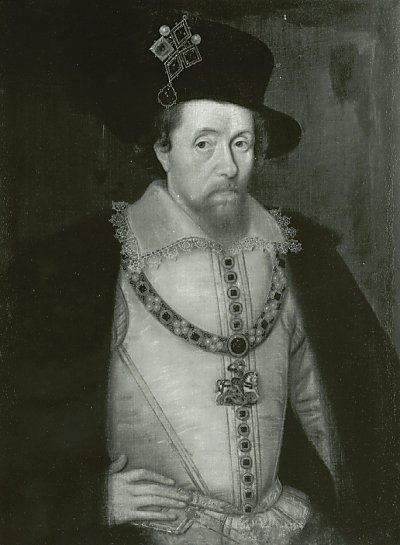
King James VI & I,
artist unknown 'detail' (Scottish National Portrait Gallery)
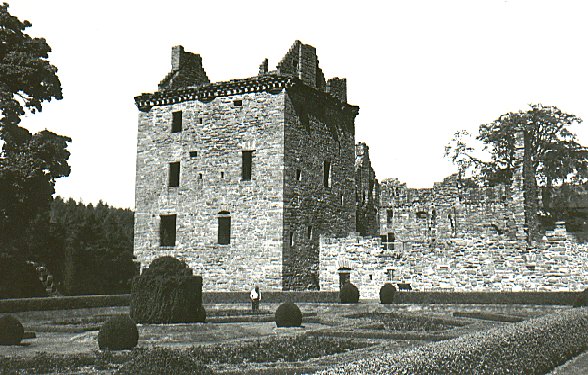
Edzell Castle. (Photo: James
Halliday)
in areas like the Highlands where the years
of unrest in the state had undone much of the work of James IV. Highland
chiefs were required to find sureties for the good behaviour of their
subordinates, and had to produce evidence for their right to hold their
lands. New burghs were established at Campbeltown, Inverlochy and
Stornoway. An attempt to introduce settlers from Fife into Lewis and
Harris was not a success, the murder of some of the incomers by displeased
islanders proving a deterrent to the recruitment of others.
Politically James's reign saw growth in the
status and importance of Parliament. In 1587 the shires were granted the
right to representation, and an increasing amount of business was now
transacted in Parliament, where shire and burgh representatives were
present, rather than in the Great Council of which they did not enjoy
membership.
The result of these policies - and the
diplomatic policy of peace and conciliation which went with them - gave to
Scotland the first reasonably enduring period of prosperity for many a
year. In this atmosphere optimism was possible, and Scottish merchants and
gentry felt it safe once again to build houses which were not likely to be
demolished in civil disorder or English invasion. Sir David Lindsay's
castle at Edzell, and Sir George Bruce's 'Palace' at Culross belong to
this period, and stand as rather touching reminders of how ready Scots
were to respond to any reasonable prospect of peace and private happiness,
both so long denied.
But, of course, controversy there was,
particularly over the development of the church. When James came to the
throne, and throughout the period of his minority the church was something
of a mongrel. It was not Catholic, as Papal authority and the Mass had
both been rejected; but equally it was certainly not Presbyterian. Bishops
and Abbots still remained among the clergy and many were still Catholic in
their own personal opinions. In 1572 a compromise was
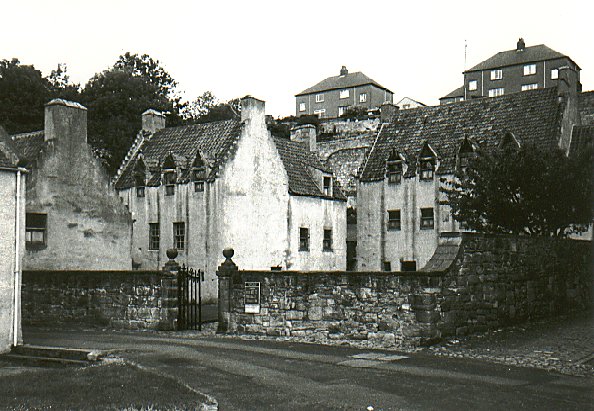
'The Palace', Culross.
(Photo: James Halliday)
agreed whereby bishops were to be retained
and nominated by the crown, but to be examined and accepted by committees
of reformed ministers; and the bishops were to be subject to General
Assemblies - the Presbyterian highest church authority - in matters of
belief and teaching.
In the mid 1570s this compromise was
attacked by the Presbyterian faction in the church led by Andrew Melville.
In 1578 Melville's Second Book of Discipline offered a Presbyterian
structure to the church; and in 1580 the General Assembly, meeting in
Dundee (consistently since the 1550s a centre of Protestant militancy),
condemned the office of bishop as unscriptural and unacceptable. The
General Assembly of 1581, meeting in Glasgow, confirmed the Dundee
decisions and seemed ready to move to adopt a full Presbyterian pattern.
But for this to be done the state would have to approve the changes, and
this the king and Council were not prepared to do.
At this point politics intruded upon
religious debate when in 1582 the General Assembly was so unwise as to
record its approval of the seizure of power and the king's person by the
extreme Protestant faction led by the Earls of Mar and Gowrie. The success
of this Raid of Ruthven (the king had been held in Ruthven Castle) was
short-lived and the Presbyterian hopes were dragged down in defeat
together with the faction which the Assembly had unwisely supported.
There followed for the next twenty years or
so a process of ebbing and flowing as Assemblies and Parliaments moved
nearer to Presbyterianism or further from it. The king, however, had made
up his mind. Intellectually he rejected the Presbyterian pattern, largely
because it was at total variance with his concept of monarchy. James
believed himself, like all monarchs, to be chosen by God, and saw himself
therefore the proper leader of his people in their religious as in their
worldly lives and practices. This idea of royal supremacy was wholly
unacceptable to Presbyterians who believed, theoretically at least, in
equality of all worshippers in the eyes of God. They rejected any
distinction between clergy and laity, or any hierarchy in the church.
James and Melville had a memorable confrontation on this very issue in
1596, during which Melville seized his king by the sleeve, for emphasis no
doubt, calling him 'but God's silly vassal' and informing the outraged
James that in the kirk, the kingdom of Christ, 'King James the Saxt, is
nocht a king, nor a Lord, nor a heid, but a member.' James never forgot
that incident which clearly convinced him that Presbyterianism and
monarchy could not co-exist.
In 1597, taking clever tactical advantage
of the General Assembly's request that the church should be represented in
Parliament, James agreed promptly, and invited the bishops to serve in
Parliament as the church's representatives.
This was the position, when in 1603
Elizabeth of England died and James, who had painstakingly cultivated
good, humble relations with the English queen, was called to the throne to
which his mother had aspired. She and Darnley had been Elizabeth's
rightful heirs, and now their son enjoyed the inheritance.
Enjoyed is the right word to use. There was
no such thing as a 'Union of the Crowns'. The king of Scots merely, and
personally, inherited an additional office, which paid much better than
his old one. The two kingdoms were in no sense united, and Scotland was
left in the hands of managers while her king went off to better himself.
In England his standard of living was higher. The respect accorded him was
vastly superior to anything he had experienced in Scotland. In England,
monarchy James found, was more like what monarchy should be. And
furthermore, he could now put Presbyterians in their place.
One of his first acts as king of England,
was to summon to Hampton Court delegates who would devise for the church
in England a structure to which all would be asked to conform. At the
conference one delegate was unwise enough to mention some merits for
Presbyterianism. 'A Scottish presbytery,' said James ('somewhat stirred'
as the report tells us), 'as well agreeth with a monarchy as God with the
Devil . . . Jack and Tom and Will and Dick shall meet and at their
pleasures censure me! . . . I will apply it thus, my lords the bishops . .
. if once you were out and they in place I know what would become of my
supremacy. No bishop, no king.' And with that statement of principle and
political conviction, King James presented the challenge which cost his
grandson and his family the throne. For the rest of the century, if any
man was hostile to episcopacy he must be ready to extend his hostility to
the crown, and to expect hostility in return. Similarly, if anyone were to
seek to limit royal power, he must be prepared to face the hostility of
the episcopal establishment. Just as James's mother and grandparents had
entangled the crown with the Catholic church and the French alliance, so
now James and his successors had bound monarchy and episcopacy into a
political alliance which none could see to break.
While events went his way in England, James
was able to take pride in the state of affairs in Scotland. 'This I must
say for Scotland, and may truly vaunt it; here I sit, and govern with my
pen, I write, and it is done; and by a clerk of the council I govern
Scotland now which others could not do by the sword.' James's very absence
from Scotland was really an advantage. Free from pressures and arguments
he simply passed on his wishes to his officials, who saw them carried out.
But James had qualities of shrewdness and administrative cunning which had
given his Privy Council in Scotland tasks which were manageable and goals
which were attainable. When he died in 1625, and was succeeded by solemn
and politically incompetent Charles I, it quickly became clear that the
success of James's system could be attributed in the end to the man who
devised it.
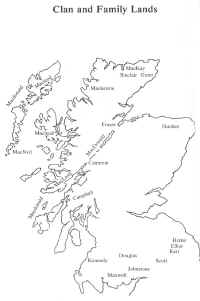 Charles
shared his father's notion of Divine Right, and his belief that kings
should be immune from the kind of criticism and correction appropriate for
lesser mortals, but he had none of his father's understanding of how far
and how fast he could go in pursuing his objectives. He wanted to enhance
the wealth and status of the church as it now existed, with its episcopal
structure. He wanted to bring order and conformity into that church, and
he chose to help him Archbishop Laud of Canterbury, one of these
tidy-minded souls who see some virtue in having everyone do the same thing
in the same way at the same time. Uniformity was the aim of archbishop and
king, and that uniformity they wished to extend to Scotland as well. Charles
shared his father's notion of Divine Right, and his belief that kings
should be immune from the kind of criticism and correction appropriate for
lesser mortals, but he had none of his father's understanding of how far
and how fast he could go in pursuing his objectives. He wanted to enhance
the wealth and status of the church as it now existed, with its episcopal
structure. He wanted to bring order and conformity into that church, and
he chose to help him Archbishop Laud of Canterbury, one of these
tidy-minded souls who see some virtue in having everyone do the same thing
in the same way at the same time. Uniformity was the aim of archbishop and
king, and that uniformity they wished to extend to Scotland as well.
Charles's financial requirements had
aroused annoyance among landowners, and his deference and favour shown to
churchmen, including his appointment of Archbishop Spottiswoode to the
office of Chancellor, annoyed the nobility who had grown accustomed to
seeing politics treated as a secular activity in which laymen might expect
any preferments. In 1634 the Scottish Parliament presented to Charles a 'Supplication'
in which grievances were stated, and the king was invited to alter his
political course. Obstinate and self-righteous Charles would not budge. In
1637 heated controversy arose over the use of the new Prayer book which
Charles now required to be used in Scottish churches. The response of the
Scots in February 1638, was to produce the National Covenant. It is a
long, and in general, dull document, but its signatories bound themselves
to maintain the form of church government most in accord with God's will
(Presbytery in other words) by force if necessary. This is what made the
Covenant a revolutionary document.
From the challenge there sprang the Bishops
Wars of 1639-40, and in seeking to provide himself with the strength
necessary to put down the Scottish rising, Charles had to call into
existence his English Parliament which alone could provide him with the
money which his planned military campaign would cost. He found that the
House of Commons would grant him money only upon conditions, and this
began the series of events which culminated in the outbreak of Civil War
in England in 1642.
The conflict in Scotland soon merged into
this Civil War, as Scottish factions found themselves taking sides and
making alliances with their English counterparts. In 1643 the majority
faction in Scotland, supporters of the National Covenant, entered into an
agreement with Charles's English adversaries whereby a Scottish army would
be sent to assist the Parliamentary forces receiving in return a guarantee
that, if the king were defeated, Presbyterianism would be not only secured
in Scotland, but imposed in England and Ireland as well. To this agreement
was given the name of 'Solemn League and Covenant', and in pursuit of this
improbable objective a Scottish force played a major role in the defeat of
the Royal army at Marston Moor, which effectively lost Charles the north
of England.
Other Scots too, however, were active in
the king's cause. When the Bishops' Wars began there was a very
united front against the king; but a civil war which aimed at the defeat
of the king and a threat to the monarchy as such, roused conflicting
opinions. James Graham, Marquis of Montrose, was Presbyterian in sympathy,
and had been a leading signatory of the National Covenant. He had shown
himself a vigorous and gifted military commander during the fighting in
Scotland, but he had come to realise that his colleagues were aiming not
just at a Presbyterian establishment, but at a drastic curbing of the
power of the king, if not indeed the actual destruction of the monarchy.
His suspicious hostility was aroused in particular by the behaviour of the
nobleman who had emerged as leader of the Covenanter party, Archibald
Campbell, Marquis of Argyle. With very little encouragement from the king,
Montrose formed a Royalist army in Scotland and, with assistance from
Alistair MacDonald - 'Colkitto' - and his men from Ireland, he inflicted
upon the Covenant's armies and upon Clan Campbell, a series of crushing
defeats. Despite his successes - at Tippermuir, Kilsyth and Inverlochy -
Montrose's brilliance was not enough to win against the battle-hardened
Scottish forces which, withdrawn from England, met and destroyed the
Royalist army at Philiphaugh. Royal defeat at Naseby virtually ended the
war in England, and Charles surrendered to the Scots in their camp at
Newark. His hope, possibly, was to play off the Scots against their
Parliamentary allies, but he was unsuccessful. The Scots, albeit with
reluctance, and under what amounted to threats, surrendered their prisoner
and left England. They were unwise enough to accept their expenses for
their costs in the war, and provided jibing Royalists in years to come
with the jingle 'Traitor Scot, sold his king for a groat.'
While in custody, Charles maintained
contacts with many of those moderate opponents who did not feel happy to
see Scotland under Argyle, and England under the religious extremists, who
were increasingly influential in Parliament. One such group of Scots,
under the Marquis of Hamilton, invaded England on the king's behalf but
were crushed by the English army at Preston in 1648. It was this episode
which cost Charles his life. He had invited on to English soil a foreign
army, and many hundreds of Englishmen were now dead who would have been
alive but for his actions. Pointing to what in another person would have
been treason, the English military leaders were able to have Charles put
on trial and executed in January 1649.
The execution of the king proved to be a
mistake of the first magnitude. The Scots, feeling perhaps responsible for
Charles's fate, and aggrieved because they had not been at all consulted,
now changed sides. The King's heir was recognised as Charles II on
condition that he would observe the National Covenant and the Solemn
League and Covenant. This action brought upon the Scots an English
invasion led by England's foremost military leader, Oliver Cromwell, who
crushed the Scots at Dunbar. In one last desperate fling, the young
Charles II, crowned the King of Scots by Argyle himself, conducted a
counter invasion of England only to see his army broken at Worcester.
Charles fled into exile, and Cromwell and his generals proceeded to
conquer Scotland. A victory at Inverkeithing, and the successful storming of Dundee by General George Monck, gave
England military control, and for the first time ever English forces
really had conquered Scotland. Scotland was incorporated into the English
state and Parliamentary system, there to remain, until the death of
Cromwell, and political confusion in England prompted General Monck to
lead his army to London, and call the survivors of the English Parliament
into session to resolve the crisis. That Parliament, as Monck knew it
would, invited Charles II to resume the throne, and the monarchy was thus
restored in 1660.
The now victorious royalists, in both
England and Scotland, came back to power with natural thoughts of revenge.
All those who had played any part in the revolutionary successes were seen
as beaten traitors upon whom retribution might properly fall. In Scotland,
the major target was Argyle. He had certainly changed sides and supported
Charles II, but this was not sufficient to erase royalist memories of the
other actions, including the defeat and execution of Montrose who had made
a more genuinely royalist attempt to claim Scotland for Charles II in
1650. Argyle now followed his great rival to the scaffold in Edinburgh.
Revenge was now carried out by legislation.
The Restoration meant more than simply the return of the monarchy. By the
Rescissory Act in 1661 all legislation passed since 1633 was declared null
and void. This meant that both the Covenants were renounced, and an
Episcopal church was re-established. Episcopacy had three crucial features
- hierarchy of Bishops; lay patronage (the right of landowners to appoint
the parish clergy) and royal supremacy (the king as 'head' of the church).
By 1669 specific Acts of Parliament had restored all three features.
What was now to become of those who refused
to accept the new arrangements? Parish ministers were ordered to submit
themselves for reappointment by the new Bishops. Some 300 refused, and
were 'outed' from their charges, their places going to men prepared to
serve, enthusiastically or resignedly, within an episcopal system.
Crown policies and episcopal church
government were now more clearly than ever closely inter-connected, and
opposition to one inevitably involved opposition to the other. A convinced
Presbyterian now found it diffficult to be an obedient subject, and a man's
religious zeal could almost be measured by the extent of his disloyalty to
the king.
Those whose consciences prompted them to
disobedience began by refusing to attend church services held under the
new authority, attending instead services conducted by an 'outed'
minister. This disobedience was met by a series of fines. Non-attendance
at the official services was punished by a fine; attendance at
non-official services was punished by another fine. These non-official
services were conducted in private houses or premises, and became known as
'conventicles'. Everyone attending a conventicle was liable to a fine; and
heads of families were held responsible for the behaviour of their
dependants. In due course they were even held responsible for the
behaviour of their tenants or servants. The fines were on a scale so harsh
that a family incurring them all, would very rapidly be economically
ruined.
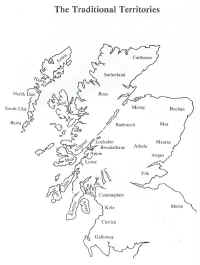 So,
secrecy became desirable, and conventicles came to be held not in private
buildings, but in the open air, in some spot remote enough to avoid
detection. Outed ministers were compelled by law to move twenty miles from
the pulpits which they had previously occupied, and, as conventicles
continued, a new law provided that ministers conducting such services were
to face the death penalty. Thus there now began another great national -
or at least local - tradition; ministers, fugitives, with a price on their
heads, worshippers in breach of the law, and armed guards protecting the
conventicles against the possibility of attack from royal military
patrols. When death is the penalty to be faced, then hunted men and their
defenders will more readily inflict death upon their pursuers. So,
secrecy became desirable, and conventicles came to be held not in private
buildings, but in the open air, in some spot remote enough to avoid
detection. Outed ministers were compelled by law to move twenty miles from
the pulpits which they had previously occupied, and, as conventicles
continued, a new law provided that ministers conducting such services were
to face the death penalty. Thus there now began another great national -
or at least local - tradition; ministers, fugitives, with a price on their
heads, worshippers in breach of the law, and armed guards protecting the
conventicles against the possibility of attack from royal military
patrols. When death is the penalty to be faced, then hunted men and their
defenders will more readily inflict death upon their pursuers.
The actual holding of conventicles was not
in itself the major cause of worry to the authorities; officials' anxiety
was aroused rather by what was there said and discussed. Sermons tended to
deal with contemporary issues, albeit thinly disguised as commentaries on
events recorded in the scriptures. 'Preaching to the times' was how they
put it. Villainous rulers in ancient Israel, and biblical examples of
tyranny and persecution, were used to teach lessons which were not lost
upon the congregation. So discontent simmered, conventicles continued, and
patrolling soldiers policed the disaffected areas, notably Fife and the
south-western countries. John Graham of Claverhouse, one of the military
commanders, once remarked irritably that there were in Galloway 'as many
elephants and crocodiles as there are loyal and regular persons.'
If discontent and sedition smoulder away
for a long period the instinct of governments is usually to try to bring
the unrest out into the open where it can be crushed. By 1677 the
authorities were frustrated and infuriated by the
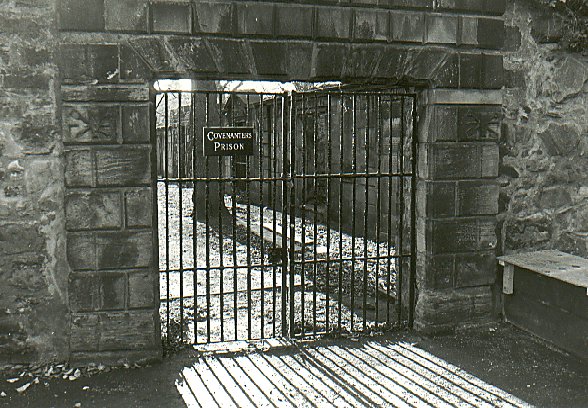
The Covenanters' Prison,
Greyfriars Kirkyard, Edinburgh. (Photo: Gordon Wright)
prolonged nature of Presbyterian resistance
to which there seemed no foreseeable end. From the Bishops there came the
suggestion that the restless areas should suffer some 'notable corporal
punishment in terrorem' which would probably provoke a rising, expose the
ringleaders, and 'render them inexcusable'. With this aim there was
dispatched into Ayrshire in the spring of 1678, an army of irregular
soldiers recruited from the estates of Royalist lairds and nobles of Angus
and South Perthshire, to which history has attached the rather misleading
name of 'The Highland Host'. They were to maintain themselves by
confiscation - living off the land in military terms - an army of
occupation in effect. The result for the southwest in loss of produce,
financial damages and physical assault and intimidation, was considerable.
But, there was no rising. The whole object
of the exercise had failed and by the end of the year The Highland Host
was withdrawn. At this point when the attempt to provoke rebellion had
failed, events played into the hands of the government. On 3 May 1679 a
group of extremist Presbyterians in Fife ambushed and murdered Archbishop
James Sharp of St. Andrews - a vigorous supporter of royal policy, a
zealous extorter of fines, and, as former parish minister in Crail, a
turncoat enjoying enormous unpopularity. The murder had disastrous
consequences. The murderers fled, some of them to seek shelter with
friends in the west, and the royal dragoons went looking for them.
Thus it was that, on 1 June, Claverhouse
and a small force came upon a large conventicle at Drumclog on the
Lanarkshire/Ayrshire border. Believing that some of the assassins were in
the congregation, Claverhouse attacked, but the conventiclers proved
strong enough to beat him off. Rebellion was now a fact. Government forces
mustered in Glasgow, and Presbyterian recruits came

The Covenanters' Memorial,
Rullion Green. (Photo: Gordon Wright)
forward to join the rebel army which now
openly stood for 'The Good Old Cause' of the Covenants. An army, generally
accepted as being from 4-5000 strong, faced the Royalist force under
James, Duke of Monmouth, one of the king's sons, across the Clyde at
Bothwell Bridge on 22 June. The result was disastrous for the Covenanters.
Disunited and squabbling, they failed to prevent the advance of the royal
army and their ranks were speedily shattered.
Bothwell Bridge gave the government all the
advantages that had for so long proved elusive. Presbyterians could now be
treated as virtual traitors, and moderates and extremists alike had to
submit to the triumphant severity of the Crown and its instruments. The
main body of Presbyterians was cowed and submissive, and 'The Good Old
Cause' was dead as far as the mass of the population was concerned.
Resistance continued, but it now came only from a tiny minority of
extremists - and potential martyrs. |

